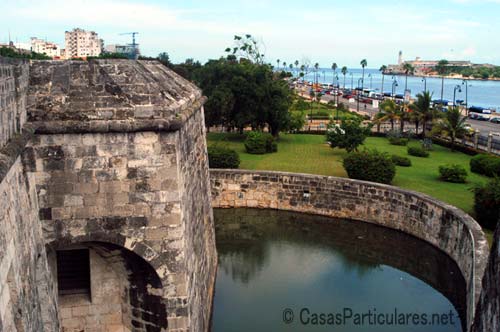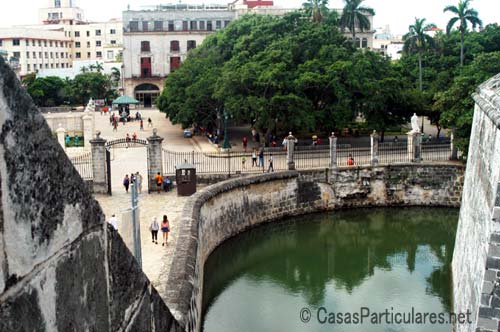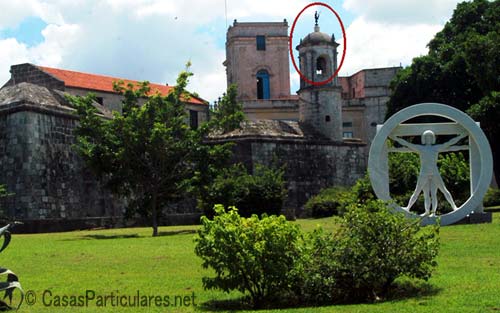The Real Force Castle
By Danil Ren, representative of the agency, translated from Spanish by Danil Ren.
The Real Force Castle (Castillo de la Real Fuerza in Spanish) is located in the very entrance of the Plaza de Armas, the most ancient place of Old Havana, the official place where the city of Havana was born. It is a military fortification built in 1558, just after the destruction of the Fuerza Vieja fortress. The Castillo del la Real Fuerza was initially built under the direction of Bartolomé Sánchez and then Francisco Colona engineers.
We deduce that "Fuerza Vieja" (Old Force) is the name that the Spanish gave to the former fortress and "Real Fuerza" (Real Force) is the name of the new, really strong, fortress, not like the "Old" one which was defeated. The original name of that former fortress seems to be unknown, probably because it was a very early step of the Cuban history and documented details about the old fortress don't exist, except these that came after its destruction.
The template of the Castillo de la Real Fuerza is a square divided in nine exactly equal parts, which distribute in four regular bastions. The fortification is surrounded by water, through a fosse limited by the perimeter wall. The work reminds the Italian and French fortifications if the XVI century, nevertheless the volume and the architectonic mass, as well as its isolation make it more similar to the Middle Age tradition.
It was built with the purpose of defending the city from the pirats, foreign armies and corsary attacks, nevertheless its location, too much innermost in the Havana Bay doesn't seem to be the best suited for this task, even if, in 1762, it managed to resist the English army and several others.
I have the opinion that the Spanish were not stupid, they knew very well what they're did. If they built the fortress as inside the bay it was evidently because its main purpose was not to reject attacks from the sea. In fact, it also had the purpose to store treasures brought from Spain. And this is where the so inermost position acquires its full meaning, and this is maybe the main reason the Spanish decided to build the fortress exactly in that place.
After all, the most suitable fortress to reject external attacks were obviously the Morro Fortress, which was built a few years after. This makes sense. Why reserve two fortresses to the same defensive purpose? It seems evident that the Morro was for the defense from the outside and the Castle was for the inside security and treasure storage. Further, the common sense suggests to consider that in that epoch, the dangers of inner steal were much more real than external invasions, which obviously existed but they were less likely to occur. Beware, these are only conjectures, personal interpretations based on the analysis of the facts, not on deep studies or official facts about the matter.
The building of this fortress took 19 years to finish even if the superior floors were built later and served as a residence for the governors. Finally, roughly in 1630, a floor was added to the stronghold in the south-east corner. In that floor the statue of the Giraldilla was placed, which represents a woman with a cross in the hand, today symbol of Havana. It is said that this bronze statue was melted in Havana in the year 1632 by the artist Jerónimo Martínez Pinzón.
The Giraldilla Legend
Such legend tells that Doña Inés de Bobadilla, wife of Hernando de Soto, the seventh Spanish governor of Cuba, and by the express order of this latter, took in charge the administration of the country when De Soto had to leave to take part of an expedition in Florida.
Accordind to the legend, Doña Inés spent hours of the day in the highest spot of the castle, with the hope to see any ship bringing her husband back, even after his death she continued to wait, converting herself to a symbol of eternal love.
This, at least was the legend. Because in reality, the Castillo de la Real Fuerza was built in 1558, much after the Hernaldo De Soto's departure (1539), and even after his death (1540). And even if she suffered a lot, Doña Inés didn't died of love, she instead returned back to Spain with a big inheritance from her husband, according to what the investigator Pedro A. Herrera López said, after having studied very ancient archives for years, among other documents and publications related to the legend.
In any case, the legend was sufficiently strong to inspire the artist Jerónimo Martínez Pinzón when he made that sculpture, which resisted to several hurricanes until that the one of October 20, 1926 pulled the Giraldilla off its pedestal, fling it to the floor. Today, the statue you see in that pedestal is a replica. The original is conserved in the City Museum, that is the former Palacio de los Capitanes Generales, so it may rest from the fury of hurricanes, which understand nothing about love stories. Today the La Giraldilla is also a symbol in the Habana Club rum logo.
But let continue to talk about the Castle's story.
The Castillo de la Real Fuerza in Later Times
After the English invasion in 1762, when taking the colonial domain back, the castle began to function as an organization center the the defense and, during the War of the 10 Years (1868-1878), it was converted into the Cuartel del Cuerpo de Voluntarios de La Habana. In 1899, the intervening American government ordered to move the National Archive in the Castle, when it remained up to 1906. And, from this moment on, it became the Rural Guard Quarter, until 1934, where the Batallón Número Uno de Artillería del Regimiento Siete, Máximo Gómez took place. Finally, between 1938 and 1957, the forteress hosted the National Library.
The Cuban Revolution took the power on 1959 and from this year one, the Castillo de la Real Fuerza hosted several high level contemporary Cuban art expositions in a non permanent way. In 1990 it became the Museum of Contemporary Artistic Ceramic and finally, starting from 2005, it became what it should be, the museum of itself. It now contains several relics of its own history and also elements related to the history of the navigation and ship building.
Today the Castillo de la Real Fuerza is one of the sites declared by the UNESCO in 1982 as the humanity heritage.












